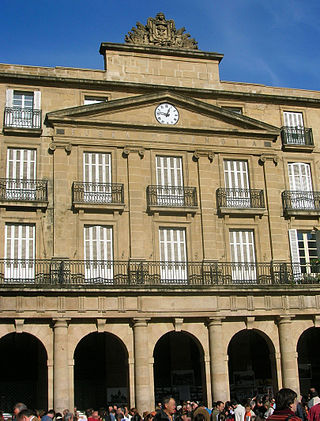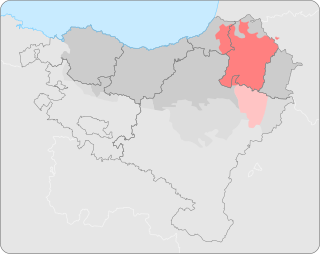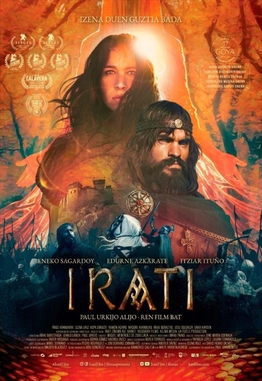
In comparative mythology, sky father is a term for a recurring concept in polytheistic religions of a sky god who is addressed as a "father", often the father of a pantheon and is often either a reigning or former King of the Gods. The concept of "sky father" may also be taken to include Sun gods with similar characteristics, such as Ra. The concept is complementary to an "earth mother".

The mythology of the ancient Basques largely did not survive the arrival of Christianity in the Basque Country between the 4th and 12th century AD. Most of what is known about elements of this original belief system is based on the analysis of legends, the study of place names and scant historical references to pagan rituals practised by the Basques.

Akelarre is the Basque term meaning Witches' Sabbath. Akerra means male goat in the Basque language. Witches' sabbaths were envisioned as presided over by a goat.

Euskaltzaindia is the official academic language regulatory institution which watches over the Basque language. It conducts research, seeks to protect the language, and establishes standards of use. It is known in Spanish as La Real Academia de la Lengua Vasca and in French as Académie de la Langue Basque.

Mari, also called Mari Urraca, Anbotoko Mari, and Murumendiko Dama, is the main goddess of the pre-Christian Basque mythology. She is married to the god Sugaar. Legends connect her to the weather: when she and Maju travel together hail will fall, her departures from her cave will be accompanied by storms or droughts, and which cave she lives in at different times will determine dry or wet weather: wet when she is in Anboto; dry when she is elsewhere. Other places where she is said to dwell include the chasm of Murumendi, the cave of Gurutzegorri (Ataun), Aizkorri and Aralar, although it is not always possible to be certain which Basque legends should be considered as the origin.

In Basque mythology, Basajaun is a huge, hairy hominid dwelling in the woods. They were thought to build megaliths, protect flocks of livestock, and teach skills such as agriculture and ironworking to humans.
Urtzi is an ancient Basque language term which is believed to either represent an old common noun for the sky, or to have been a name for a pre-Christian sky deity.

Amalur, also known as Ama Lurra was the goddess of the earth in the religion of the ancient Basque people. She was the mother of Ekhi, the sun, and Ilazki, the moon. She is also believed to not only be the goddess of the earth, but the earth itself.
Sorginak are the assistants of the goddess Mari in Basque mythology. It is also the Basque name for witches, priests and priestesses, making it difficult to distinguish between the mythological and real ones.

Cantabrian mythology refers to the myths, teachings and legends of the Cantabri, a pre-Roman Celtic people of the north coastal region of Iberia (Spain). Over time, Cantabrian mythology was likely diluted by Celtic mythology and Roman mythology with some original meanings lost. Later, the ascendancy of Christendom absorbed or ended the pagan rites of Cantabrian, Celtic and Roman mythology leading to a syncretism. Some relics of Cantabrian mythology remain.
The Aralar Range is a mountain range in the Basque Mountains of Southern Basque Country. The part of the range lying in Gipuzkoa was established as a conservation area called Aralar Natural Park in 1994. In addition to its natural features, scenery, recreational use and habitation, the range is home to number of Basque mythology milestones and legends.

Although the first instances of coherent Basque phrases and sentences go as far back as the San Millán glosses of around 950, the large-scale damage done by periods of great instability and warfare, such as the clan wars of the Middle Ages, the Carlist Wars and the Spanish Civil War, led to the scarcity of written material predating the 16th century.

Salazarese is the Basque dialect of the Salazar Valley of Navarre, Spain.

Wentworth Webster was an Anglican clergyman, scholar, and collector of folk tales of the Basque Country.

Julien Vinson was a French linguist who specialized in the languages of India, mainly Tamil, and also in the Basque language.

Akerbeltz or Aker is a spirit in the folk mythology of the Basque people. It is said to live inside the land and is believed to have as many elves as servants. In Christianity, Akerbeltz is considered the live image of the devil, performing sexual abuses against Christians.

Joseba Agirreazkuenaga is a researcher and historian. He is specialist in the history of the Basque Country particularly: the crisis of the Ancien Régime; the fueros, self-governance, the economic concert between Spain and the Autonomous Community of the Basque Country and its fiscal system, and the social movements both in Bilbao and in the Basque Country as a whole.

Irati is a 2022 Basque-language Spanish-French epic fantasy adventure film directed by Paul Urkijo Alijo which stars Eneko Sagardoy alongside Edurne Azkarate and Itziar Ituño, among others.

Imanol Larzabal Goñi, known as Imanol, was a Basque Spanish singer and composer, and a champion of Basque language and culture. He went into exile from the Spanish Basque Country twice: first during the Franco dictatorship, and again in the last years of his life due to conflict with Euskadi Ta Askatasuna (ETA), a violent Basque separatist organization.















